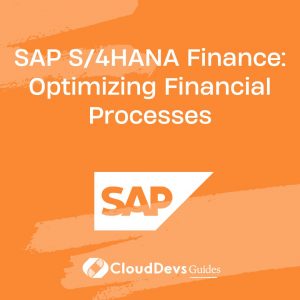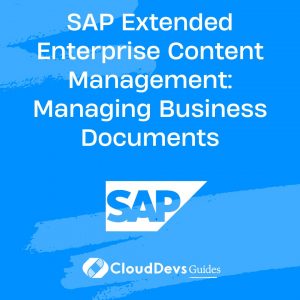SAP S/4HANA Finance: Optimizing Financial Processes
In today’s rapidly evolving business landscape, financial processes need to be agile, efficient, and data-driven to stay competitive. SAP S/4HANA Finance is a game-changer in the world of finance, offering a powerful suite of tools and features designed to optimize financial processes across organizations. In this blog, we will delve into the world of SAP S/4HANA Finance, exploring its key benefits, functionalities, and how it can transform your financial operations.
1. Understanding SAP S/4HANA Finance
1.1. What is SAP S/4HANA Finance?
SAP S/4HANA Finance is a comprehensive finance solution that is part of the SAP S/4HANA suite, the next-generation ERP (Enterprise Resource Planning) software from SAP. It’s designed to streamline and optimize financial processes, providing real-time insights and advanced analytics capabilities to drive smarter decision-making.
1.2. Key Features of SAP S/4HANA Finance
1.2.1. Real-Time Financial Reporting
One of the standout features of SAP S/4HANA Finance is its ability to provide real-time financial reporting. Traditional finance systems often rely on batch processing, which can lead to delays in accessing critical financial data. With SAP S/4HANA Finance, you can access up-to-the-minute financial information, enabling faster and more informed decision-making.
sql -- Example SQL query for real-time financial reporting SELECT * FROM financial_data WHERE date = TODAY;
1.2.2. Enhanced Predictive Analytics
SAP S/4HANA Finance leverages advanced predictive analytics to help organizations forecast financial trends accurately. By analyzing historical data and using machine learning algorithms, you can make data-driven predictions about future financial performance.
python
# Python code for predictive analytics in SAP S/4HANA Finance
import pandas as pd
from sklearn.linear_model import LinearRegression
# Load financial data
data = pd.read_csv('financial_data.csv')
# Create a linear regression model
model = LinearRegression()
model.fit(data[['Year', 'Quarter']], data['Revenue'])
# Predict future revenue
future_data = pd.DataFrame({'Year': [2024, 2025], 'Quarter': [1, 2]})
predicted_revenue = model.predict(future_data)
1.2.3. Integrated Financial Planning
SAP S/4HANA Finance integrates financial planning and analysis into one unified platform. This streamlines budgeting, forecasting, and financial analysis processes, allowing finance teams to work collaboratively and make data-driven decisions.
java
// Java code for integrated financial planning in SAP S/4HANA Finance
public class FinancialPlanner {
public static void main(String[] args) {
// Load budget data
BudgetData budgetData = loadBudgetData();
// Perform financial analysis
FinancialAnalysis analysis = analyzeFinancialData(budgetData);
// Generate financial forecasts
FinancialForecast forecast = generateFinancialForecast(analysis);
// Update budget based on forecasts
updateBudget(forecast);
}
// Methods for loading data, performing analysis, and updating budget
}
2. Benefits of SAP S/4HANA Finance
2.1. Improved Efficiency
By automating manual financial processes and providing real-time data access, SAP S/4HANA Finance significantly improves efficiency. Finance teams can focus on value-added activities rather than data entry and reconciliation.
2.2. Enhanced Decision-Making
With access to real-time financial data and advanced analytics, organizations can make informed decisions quickly. This helps in adapting to market changes, identifying cost-saving opportunities, and optimizing investments.
2.3. Regulatory Compliance
SAP S/4HANA Finance ensures compliance with financial regulations and standards. It helps in generating accurate financial reports and maintaining audit trails, reducing the risk of non-compliance.
2.4. Scalability
As organizations grow, their financial needs evolve. SAP S/4HANA Finance is highly scalable, making it suitable for businesses of all sizes. Whether you’re a small startup or a multinational corporation, this solution can adapt to your changing requirements.
3. Implementing SAP S/4HANA Finance
3.1. Planning for Implementation
Implementing SAP S/4HANA Finance is a significant undertaking, but the benefits are well worth the effort. Here are some key steps to consider when planning for implementation:
3.1.1. Define Objectives and Goals
Clearly define what you aim to achieve with SAP S/4HANA Finance. Whether it’s improving financial reporting, optimizing budgeting, or enhancing analytics, having clear objectives will guide your implementation strategy.
3.1.2. Assess Current Processes
Before implementing SAP S/4HANA Finance, assess your existing financial processes. Identify pain points, bottlenecks, and areas where automation can bring the most value. This evaluation will help tailor the solution to your specific needs.
3.1.3. Engage Stakeholders
Involving key stakeholders from finance, IT, and other relevant departments is crucial. Their input and buy-in are essential for a successful implementation.
3.1.4. Choose the Right Implementation Approach
You can choose between a greenfield implementation (starting from scratch) or a brownfield implementation (migrating from an existing SAP system). The choice depends on your organization’s unique circumstances and preferences.
3.1.5. Training and Change Management
Ensure that your team receives adequate training on SAP S/4HANA Finance. A well-planned change management strategy will help employees adapt to the new system smoothly.
3.2. The Implementation Process
The implementation process involves several stages, including system setup, data migration, configuration, and testing. SAP provides comprehensive documentation and support throughout the process. Here’s a simplified overview:
3.2.1. System Setup
Set up the SAP S/4HANA Finance system according to your organization’s requirements. This includes hardware and software installation, user access, and security configurations.
3.2.2. Data Migration
Migrate your financial data from the existing system to SAP S/4HANA Finance. This step requires careful planning and validation to ensure data integrity.
3.2.3. Configuration
Configure the system to align with your financial processes. This involves defining charts of accounts, creating financial hierarchies, and setting up reporting structures.
3.2.4. Testing
Thoroughly test the system to identify and resolve any issues. User acceptance testing (UAT) is essential to ensure that the system meets your business needs.
3.2.5. Training and Deployment
Provide training to end-users and deploy SAP S/4HANA Finance across your organization. Monitor the system’s performance and address any post-deployment issues promptly.
4. Best Practices for SAP S/4HANA Finance
To maximize the benefits of SAP S/4HANA Finance, consider the following best practices:
4.1. Data Quality
Maintain data accuracy and consistency. Implement data governance practices and regular data quality checks to ensure reliable financial insights.
4.2. Continuous Learning
Stay updated with the latest features and capabilities of SAP S/4HANA Finance. Continuous learning and training help you make the most of the system’s capabilities.
4.3. Collaboration
Encourage collaboration between finance and other departments. SAP S/4HANA Finance enables cross-functional teamwork for better decision-making.
4.4. Security
Prioritize data security. Implement robust access controls and encryption to protect sensitive financial information.
4.5. Monitoring and Optimization
Regularly monitor system performance and financial processes. Identify areas for improvement and optimization to enhance efficiency further.
Conclusion
SAP S/4HANA Finance is a powerful tool for optimizing financial processes in today’s dynamic business environment. By providing real-time data, advanced analytics, and streamlined processes, it empowers organizations to make smarter financial decisions, drive efficiency, and stay compliant with regulations. While the implementation process may be complex, the long-term benefits are substantial, making SAP S/4HANA Finance a valuable investment for businesses of all sizes. Embrace the future of finance with SAP S/4HANA Finance and take your financial operations to the next level.
Are you ready to transform your financial processes with SAP S/4HANA Finance?
Table of Contents









